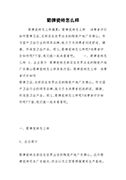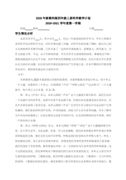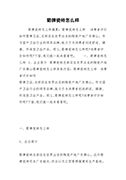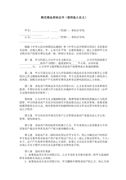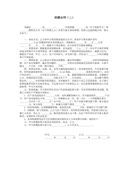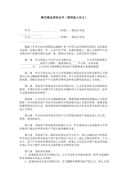《牛津小学英语》教案(精选17篇)二年级英语教案
《牛津小学英语》教案(精选17篇)
《牛津小学英语》教案 篇1
一、教学内容
part b, c
二、教学目标
1. 能听懂,会说,会读单词:storybook, copybook, knife, toy train, tape, stapler, school bag, , in, on, in english
2. 能听懂,会说,会读句子:
a) what’s this/that in /on the …?
b) what’s this/that in english?及其应答句。
3、初步学会用英语询问物品的名称。
三、教学重点
1. 能正确朗读以下单词:knife, tape, stapler, crayon
2. 能正确区分this/that, in/on, tape/tap
四、教学过程
step 1. greeting.
t:happy new year to you all, boys and girls.
ss: the same to you.
t: how is your vacation?
s1: good.
s2: not so good.
…
step 2. revision
t: look, this is my …
it’s +color. how nice!
look, that’s his/her …
示范后,学生操练。
step 3. presentation
t:(指着课本)what’s this in english?
s1: it’s a book. (引导回答)
t: where?
s1: on the desk. (引导回答)
领读in english,on/in
示范后,生生利用身边的文具,操练新句型
step 4. learning new materials:
1. 将要学习的新单词实物放进袋子里,让学生随意挑选后,主动发问:what’s this/that in english?可求助老师,也可以求助同学。
2. 逐一板书新单词时,要求学生拼读。领读新单词,注重音节划分,单词构成,字母组合,新旧单词区分等方面的渗透。
如storybook, copybook ; crayon, day, bay ; knife ; toy train, boy ;tape , tap ; school bag ; sta pler
3. 游戏操练新单词。如高低声,看口形猜单词等。
4、利用图片或实物,操练单复数。a stapler? yes/no. some crayons? yes/no. …渗透复数概念,并强调knife---knives.
5.看b图说话。what can you see ? i can see a …
6.通过图片、实物、多媒体等方式创设情境,操练新句型:what’s this/that in/on the …?
step 5. consolidation and practice
1. 指导完成c部分的看图说话。
2. 条件允许的情况下,可将四段对话打印出来,让学生阅读后配对。
step 6. homework
1. 抄写b中词汇,每个两遍,中文一遍。
2. 跟磁带朗读b中词汇五遍,并拼读。
3.看图说话,自己操练c部分。
4. 准备一个自己感兴趣的物品,下节课带到课堂上。
注意点:
1. 教学内容较多,把握好时间分配,尤其是新授部分内容要予以充足的时间保证。
2. 新授单词,句子不要苛求每个学生都掌握得很熟练。
教学过程中要高频率,快节奏,充分激发学生的兴趣。
《牛津小学英语》教案 篇2
教学内容: 《牛津小学英语》4b第八单元第一课时
二、教学目标 :
1、 能听懂、会说,会读,会拼写单词a chair, a blackboard, a picture, a bookcase, a classroom, an office, a playground 。
2、 能听懂、会说,会读,会写句型 there's a / there are some ...in/ on/ near the ...
3、 熟悉歌曲 in the classroom 。
三、教学重点和难点:
1、 能听懂、会说,会读,会拼写单词a chair, a blackboard, a picture, a bookcase, a classroom, an office, a playground 。
2、 能听懂、会说,会读,会写句型 there's a / there are some ...
五、课前准备
教具准备 :
本课课件 及磁带录音机。
六、教学过程 step1. free talk:
1.师生用good morning/afternoon. how are you?互相问候。
2.出示课件,看图片复习学过的单词(食物类、水果类、职业类、家庭用品类)。
重点复习本课中的复现单词:a computer, a chair, a bookcase.
3.复习句型:let's go to the library. great! how do we go there? shall we go to thereby bus? ok. 练习"there" ,并书写。
4. let's sing the song 《the wheels on the bus 》,(出示课件音乐,并在每个地点类单词图片出现前播放)。
step2. presentation and practice
1、 出示library的图片。 t: look at my picture.
出示单词picture 并领读 s: 跟读. t:(指图片) what's this ? s: it's a library. t: what can you see in the library? s: i can see a picture , a computer and some bookcases.
2、出示课件歌曲《wheels on the bus 》 t:(出示office的图片)what's this ? s: …… t: it's an office .. 出示单词 office 示范朗读 s:跟读 t:what can you see in the office ? s: i can see a computer . t: so you can say: there is a computer. can you say like me? 出示句型:there is a/an …… can you say like me? s: there is a computer. there is a ... s:造句练习。
3、听音乐,做动作,出示classroom的图片 。 t: what's this ? s: it's a classroom . 出示单词 classroom 并领读 s:跟读 t: what can you see in the classroom?出示blackboard 的图片。 s: there's a blackboard . 学生造句练习…… t: 出示复数句型there are some …… s: (在教师帮助下 ) there are some desks . 学生学说并做造句练习。
4、同法教 a playground, a music room.
step3 a short break
1、enjoy a song 欣赏本课的歌曲 in the classroom
2、a game" magic ears” 游戏规则:教师说本课单词,不发出声音,仅让学生看口型,学生根据教师口型猜测是什么单词。
step 4. learn to say
1、在黑板上写出课题unit8 open day 并领读
2、出示本课单词图片。学生看图说单词。
3、t:(示范)this is an office. there is a/ an... on/ in the... there are some ...on/ in the ... can you say something like that? s:模仿教师练习句型。
step5 consolidation
1、看图说话比赛 ,练习书上part.c 教师出示书上图片。 学生分两大组比赛哪组说的多,说的好。 用句型: there is /are.... in / on the...
step 6 homework
1、听磁带,跟录音读对话。
2、单词抄写,各三遍。
附板书:
unit 8 open day
there is a /an……
there are some ……
《牛津小学英语》教案 篇3
一、教学内容
part a,b,c
二、教学目标
1.能熟练地听、说、读本单元所学单词、句型。
2.能初步将本单元句型运用到日常交际中。
3.能在教学活动中,感受到成功和快乐。
三、教学重点
1.能初步将本单元句型运用到交际中。
四、教学过程
step 1. greeting.
(日常问候语)
step 2. revision
1) free talk
师出示与本课内容相关的文具残缺图片若干,操练句型:
what’s this/that in english? 及其应答
2) 学习歌曲what is this in english?师示范后,学生跟唱。
3) 鼓励学生挑选喜欢的图片,小组创作新歌词,并集体演唱。
step 3. activity
1.i can draw a …跟着老师画文具类简笔画
2.listen and point.
3.listen and color.(师提供颜色,生自己涂色)
4.让学生将这些新文具摆放到合适的地方。建议:in the pencil box/desk/book; on the pencil box/desk/book等
5.师示范新对话,并让学生跟读。
如:
a: come here ,…
b:all right.
a: excuse me, what’s this on your book.
b: oh, it’s my tape.
look, it’s new.
it’s green and white.
it’s from my dad.
it’s on my book now.
6.学生以小组为单位,编新对话,并表演。
step 4. homework
1.将课上自己编的歌曲歌词以小报的形式展示出来。
2.口头向父母介绍自己的文具。
注意点:
1.活动课不能搭建花架子,所设计活动要紧紧围绕教学重点。
2.活动过程中要用语言,不仅用本单元,更要考虑到前面的知识联系。
活动资源要用足,用好。
《牛津小学英语》教案 篇4
一、教学内容
part a,b,c,e2,e3
二、教学目标
1. 学会唱字母歌。
2. 能在熟练掌握本单元所学单词、句型基础上,巩固复习3a中文具类,动物类,交通工具类,食品类单词。
3. 能将本单元句型熟练地运用到日常交际中。
4. 能在教学活动中,感受到成功和快乐,增加学习英语的兴趣和自信。
三、教学重点
1. 能将本单元句型熟练运用到交际中。
四、教学过程
step 1. greeting.
learn to sing the song ”a b c” together.
step 2. revision
1) have a dictation
可以适当增加听音填字母的项目,促使学生尽快熟悉简单的读音规律,为记忆单词打下基础。
2)小组竞赛,说出文具类词语。
3) game. 模仿教材e2中形式进行。句型可以略作调整。what’s this in my school bag? it’s a …
规则:
1. 四人小组进行游戏。
2.摸物品,每人2次机会,答对的同学可以将物品放在自己的位置上。
3.最后物品最多的同学即是赢家。
4.若有同学用中文,失去一次猜谜机会。
step 3. consolidation and practice
1. t: you did a good job. i’d like to buy a toy for my nephew. would you like to go with me? guess, what can you see in the toy shop?
复习动物类,交通工具类,家具类词汇。
2. 情境一,示范对话,并让学生跟读。
a: hello, … how are you?
b: fine, thank you. and you?
a: i’m fine , too. let’s go to the toy shop by bus.
b: ok, let’s go.
a: here we are.
b: look, what’s that on the door?
a: it’s a …
b: oh, i see. come here, … what’s this on the desk?
a: it’s a …
b: how nice!
a: a …, please.
c: ok, here you are.
…
3. 小组合作,看图编对话。
4.情境二,买完玩具,一起去kfc吃了点东西。正巧遇到了一位外国人,相互自我介绍后,又相互请教了食品名称。
示范:(根据本班实际情况,选择是否继续示范)
a: hi, my name is … what’s your name?
b: my name is …i’m an english … i’m from …
nice to meet you.
a: nice to meet you, too. excuse me, what’s this in english?
b: it’s a packet of chips. what’s this in chinese?
a: han bao.
b: oh, i see. thank you.
5. 同桌模仿例子,编新对话。(师将提供的食品图片贴在黑板上)
step 4. homework
1. 跟磁带,大声朗读本单元课文五遍。
2. 提供图片及句子,请学生给句子排序,变成对话。
注意点:
1. 要在充分复习后,给学生创设表达的机会。
2. 情境创设要简洁,大情境中设置若干个小情境。
3. 运用前有示范。若学生情况好,可以逐渐放手。
《牛津小学英语》教案 篇5
一、教学内容
part a
二、教学目标
1. 能初步熟练地听、说、读上节课所学单词、句型。
2. 能听懂,会说,会读句子:
a) come here.
b) excuse me.
c) oh, i see.
3、能听、说、读、写单词bag, book ,tape
4、初步学会用英语有礼貌地询问物品的名称。
三、教学重点
1. 能正确朗读课文。
2. 能科学记忆四会单词。
四、教学过程
step 1. greeting.
t:good morning.
ss: good morning.
t: how are you?
…
step 2. revision
1) free talk
师示范: excuse me, what’s this/that in english?
it’s a …
领读excuse me。师生,生生间相互问答。
2)小诗复习单词
a crayon, a crayon.
it’s in the desk.
a knife, a knife.
it’s on the chair.
鼓励学生自己边摆文具,边创作小诗。
3) 完成教材e1听力练习。
4) look at these words carefully.
bag , cat , fat , dad
book , look , cook , hook
tape , name , kate
大声读完后,让学生试着总结后,集体背诵单词。
step 3. presentation
a: come here, …
b: all right.
a: excuse me, what’s this/that in/on the box?(利用遮盖等方式创设信息差,提高语言运用的真实性)
b: it’s a …
a: oh, i see. thank you.
b: that’s ok.
step 4. learning new materials
1. 领读新句子:come here,oh, i see.
2. 看课文插图,回答问题。
1) who are they?
2) where?
3) what color is the …?
3. 分两次听磁带,回答问题。
1) what’s that on the desk?
2) what’s this in english?
4. 跟读课文两遍。
5. 小组读课文。
6. 分角色朗读课文。
step 5. consolidation and practice
1. 鼓励学生看着课文插图,给图中人物配音。
2. 结合练习册内容,做适当练习。
step 6. homework.
1. 跟磁带大声朗读课文a,b五遍。
2. 抄写四会单词四遍,并背诵。
注意点:
1.课文朗读时间应尽量长一点,不能走过场,或寄希望于课后。
2.复习环节要方式多样化,扎实操练。
课文处理环节要注重教材资源利用。
《牛津小学英语》教案 篇6
一、教学内容
单元小练习
二、教学目标
1、 熟练掌握本单元的(三会、四会)单词、词组、句子及对话。
2、 运用已有语言知识解决问题。
3、 通过难度适中的适量小练习,帮助学生进一步了解自身学习状况,以促进以后的学习。
三、教学重点
引导学生学会发现本单元知识的薄弱环节,以便及时调整教学策略。
四、教学过程
step 1. greeting
sing an english song.( what is this in english?)
step 2. revision
1. 师提供本节课的话题“my stationery”,鼓励学生围绕此话题与教师或同学进行交谈。
2. 生齐读a、b部分,鼓励学生总结本单元学到的知识。
1) 一些文具类的单词,并初步接触了它们的复数形式。(knife是特例)
2) 会默写3个四会单词
3) 介词in/on, 借助这两个词语,我们可以表达物品的位置。让学生举例。
4) 初步掌握my/your/his/her +名词,表示某人的东西。
5) 用途很广的几个交际用语: come here. excuse me. oh, i see.
6) 询问物品的英文名称或中文名称时,我们可以用句子……
7) 询问近处或远处东西时,可以用句子……
3、完成小练习
小练习内容如下:
一、 请读一读下面的英语,你能写出对应的中文吗?
1. storybook_______ 2. copybook_______ 3. knife_______
4. toy train_______ 5.tape_______ 6.stapler_______
7. school bag_______ 8. in english_______ 9. in chinese_______
10. my pen_______ 11. your ruler_______ 12. his rubber_______
13. on the bookcase_______ 14. in the school bag_______
二、看图写单词
考察book, tape, bag.(可以适当增加1-2个与它们发音类似的单词)
三、模仿例子写复数
for example: a toy train------some toy trains
选择本课及以前学过的部分单词,其中可以设两个不规则的单词,数量控制在10个以内。
四、根据所给情境,从方框中选择合适的句子:
主要考察交际用语的掌握情况。
如:1. 需要打扰别人时,可以说:
2. 当你弄明白一件事情的时候,可以说:
3. 请某人过来,说:
4. 做错事情时说:
…
五、提供图片和句子,让学生给图中人物配上句子,并写出中文翻译。
建议: 对话控制在4句内,以本单元重点句型为训练重点。
注意点:
1. 让复习课不要成为老师的个人演讲。不要低估学生的三言两语,耐心的引导他们学会梳理知识,培养学习能力。
2. 练习内容的设计不同考试,目的重在单元基础,不可以难、偏、怪。学生通过练习可以客观的了解知识的掌握情况,老师也可以为下面的教学找准目标。
《牛津小学英语》教案 篇7
Unit 8 Open Day胡埭中心小学 王菁菁一、教学内容:《牛津小学英语》4B第八单元第一课时 二、教学目标 :1、 能听懂、会说,会读,会拼写单词a chair, a blackboard, a picture, a bookcase, a classroom, an office, a playground 。2、 能听懂、会说,会读,会写句型 There's a / There are some ...in/ on/ near the ... 3、 熟悉歌曲 In the classroom 。三、教学重点和难点: 1、 能听懂、会说,会读,会拼写单词a chair, a blackboard, a picture, a bookcase, a classroom, an office, a playground 。2、 能听懂、会说,会读,会写句型 There's a / There are some ...五、课前准备 教具准备 :本课课件 及磁带录音机。 六、教学过程 Step1. Free talk: 1.师生用Good morning/afternoon. How are you?互相问候。 2.出示课件,看图片复习学过的单词(食物类、水果类、职业类、家庭用品类)。重点复习本课中的复现单词:a computer, a chair, a bookcase. 3.复习句型:Let's go to the library. Great! How do we go there? Shall we go to there by bus? OK.练习"there" ,并书写。 4. Let's sing the song 《The wheels on the bus 》,(出示课件音乐,并在每个地点类单词图片出现前播放)。 Step2. Presentation and practice 1、 出示library的图片。 T: Look at my picture. 出示单词picture 并领读 S: 跟读. T:(指图片) What's this ? S: It's a library. T: What can you see in the library? S: I can see a picture , a computer and some bookcases. 2、出示课件歌曲《Wheels on the bus 》T:(出示office的图片)What's this ? S: ……T: It's an office .. 出示单词 office 示范朗读 S:跟读 T:What can you see in the office ? S: I can see a computer .T: So you can say: There is a computer. Can you say like me? 出示句型:There is a/an ……Can you say like me? S: There is a computer.There is a ... S:造句练习。 3、听音乐,做动作,出示classroom的图片 。T: What's this ? S: It's a classroom . 出示单词 classroom 并领读 S:跟读 T: What can you see in the classroom?出示blackboard 的图片。 S: There's a blackboard . 学生造句练习……T: 出示复数句型There are some …… S: (在教师帮助下 ) There are some desks . 学生学说并做造句练习。4、同法教 a playground, a music room. Step3 A short break 1、Enjoy a song 欣赏本课的歌曲 In the classroom 2、A game" Magic ears” 游戏规则:教师说本课单词,不发出声音,仅让学生看口型,学生根据教师口型猜测是什么单词。 Step 4. Learn to say 1、在黑板上写出课题Unit8 Open day 并领读 2、出示本课单词图片。学生看图说单词。 3、T:(示范)This is an office. There is a/ an... on/ in the... There are some ...on/ in the ... Can you say something like that? S:模仿教师练习句型。 Step5 Consolidation 1、看图说话比赛 ,练习书上Part.C教师出示书上图片。 学生分两大组比赛哪组说的多,说的好。 用句型: There is /are.... in / on the... Step 6 Homework 1、听磁带,跟录音读对话。 2、单词抄写,各三遍。 附板书: Unit 8 Open Day There is a /an…… There are some ……
《牛津小学英语》教案 篇8
教学内容:c部分 work in pairs
教学目标:
1、能听懂、会说、会读、会写句型do the boys jump higher than the girls? does jim swim slower than david?及其答语。
2、能正确看懂图意,并能灵活运用。
教学重点:能当堂掌握四会句型do the boys jump higher than the girls?does jim swim slower than david?
教学难点:区别do 以及does的不同用法,明确助动词后面动词用原形。
教具准备:幻灯片、图字卡、计时器(以便游戏时计时)、小星星(上面写着well done.以激励学生)。
教学过程:
step1 review
1. 把单词补充完整,并说说单词的中文意思。(幻灯片出示)。
l____w ( ) ____ ____rly( ) w____l____( )
l___t___( ) str___n____( ) f___ ____t ( )
你知道这些单词的比较级怎么写吗?
2. 游戏“碰地雷”。
游戏规则:读小黑板上的单词,在其中一词下面“埋”一颗地雷,读到该词时不能读出声,否则将被地雷“炸掉”。
游戏目的:巩固新单词的读音。
3. 合作游戏 (句子接龙)
游戏规则:每组抽一张图字卡、第一个学生说出一个词,第二个学生补充。比如s1:fast s2:run fast s3:ben runs fast s4:ben runs fast than jim。
游戏目的:巩固副词比较级的用法,增强语言学习趣味性。
step2 presentation
1. read, match and write
①questions:(幻灯片出示)
a. do the dogs swim slower than the ducks?
b. does the bee fly higher than the bird?
c. do the tigers run slower than the pandas?
d. does the rabbit jump farther than the cat?
②find the difference.找不同。
仔细读幻灯片中的句子,体会四个句子间的相同点与不同点。
③use the dialogues above as models, then make a sentence.
引导学生分别以do, does开头问两句话,体会do, does的不同用法。
注意,助动词后动词用原形。
2. check the answers.(上一节课的家庭作业练习册第9页)
3. read the sentences.
4. look, complete and answer.
_______ the boys jump higher than the girls?
________jim swim slower than david?
看图,填空并回答。
在回答的过程中,学习答语yes,…do / does. no,… don’t / doesn’t,及其句式he swims faster than david.
5. practise in pairs.
6. 换词练习
do the boys ______ ______ than the girls?
does jim ________ ________ than david?
a. work in groups.
b. check.
step3 work in pairs.
talk with your partner. use the dialogues above as models. the words in the box will help you.
fast slow high low
early late well fat
1. read the words in the box.
2. oral work:talk with your partner.
3. writing work.指导写话
指名上台板书八句话(最好写在幻灯片上)。
注意纠正学生句子中一些拼写或语法上的错误。
4. play a game:快言快语
游戏规则:小组内每人读板书中的一句话(例句两句、外加八句练习中的,共十句话),并计时,全部读完用时最少的一组获胜,每人将得到一颗写有well done的小星星。
游戏形式:小组内合作、小组之间竞争。
游戏目的:巩固所学四会句型,培养英语脱口而出的能力,增强合作与竞争的意识。
step4 consolidation
1. 完成补充习题第5页,d. look and write
①look and read by yourselves.
②discuss in groups.
③write the answers.
④check the answers.
2. play a game:musical chair 抢椅子
游戏规则:
小组活动,每次有5个学生参与,只摆放4把椅子。
①放音乐,学生围着椅子走。
②音乐停,学生坐到椅子上。没有坐上椅子的那一个学生被淘汰、被罚说一段对话,模仿练习册d部分。
③顺利完成任务的学生、奖励一枚写有well done的小星星。
游戏目的:
巩固所学句型,增强英语学习的趣味性。
step5 布置作业
1. 听力练习。listen and tick 完成补充习题第4页
2. 书面作业,仿写句子。(书上第17页)
3. 预习a部分课文。
板书内容:
四会句型do the boys jump higher than the girls? does jim swim slower than david?及其答语。
板书设计:
《牛津小学英语》教案 篇9
教材依据:《牛津小学英语》6a unit 7 at christmas a部分。
教学目标:
1. 学生能听懂、会说、会读和会拼写单词:watch, teapot, wallet, hairdryer, calculator, skateboard, mine, yours, his, hers, theirs.
2. 学生能听懂、会说、会读和会写句型:whose … is it? whose … are they?及其回答。
3. 学生初步掌握a部分的对话。
教学重点:b部分单词和句型
whose … is it? whose … are they?及其回答。
教学难点:名词性物主代词的用法。
课前准备:多媒体课件。
教学过程:
step 1. greetings. (会话导入)
1. t: hello, boys and girls. my name is vicky, your name please? s: my name is …
t: nice to meet you. s: nice to meet you, too.
t: how are you? s: fine, thank you. and you? t: i’m fine, too.
2. t: i want to make friends with you. let’s sing a song <make new friends>.
这一步骤主要是通过询问学生姓名,互问身体情况等与学生拉近距离,并且通过演唱歌曲<make new friends>让学生感觉到老师和他们的距离很近,同时也是让他们做好上英语课的准备,调动学生说英语的积极性。
step 2. learn the new words. (新授b部分单词)
1. show a calendar. t: today is the 25th of december. it’s christmas day.
show the pictures and the words ‘christmas, christmas day, merry christmas, christmas tree.’
2. t: on christmas day, people always sing <ring, ring, ring the bells>
listen to the song.
让学生在特定的情境中展开对话而不是进行机械的无意义的对话,这样比较符合小学生的学习特点,因此我采用圣诞节这一情境带出圣诞快乐、圣诞树等词语。并且让学生听一听人们通常在圣诞节这一天唱的歌曲来感受圣诞节的气氛,同时也是为下面用圣诞礼物引出新单词做铺垫。
3. t: merry christmas! i have some christmas presents. please look at the picture.
draw a watch on the blackboard.
t: what is it? s: it’s a watch.
write the word on the blackboard, students read and spell the word.
4. draw a teapot on the blackboard.
t: it’s a teapot.
write the word ‘teapot’ on the blackboard, students read the word after the teacher.
5. draw a wallet on the blackboard.
t: it’s a wallet.
write the word ‘wallet’ on the blackboard, students read the word after the teacher.
6. draw a hairdryer on the blackboard.
t: it’s a hairdryer.
write the word ‘hairdryer’ on the blackboard, students read the word after the teacher.
7. draw a calculator on the blackboard.
t: it’s a calculator.
write the word ‘calculator’ on the blackboard, students read the word after the teacher.
8. draw a skateboard on the blackboard.
t: it’s a skateboard.
write the word ‘skateboard’ on the blackboard, students read the word after the teacher.
9. read all the words together.
传统的出示图片然后新授单词对学生们来说已经没有了新鲜感,因此在这一步骤中我并没有这样做,而是用简笔画将这些东西画在黑板上然后再学习。因为 watch这个单词学生是学过的,学生比较容易掌握,因此我就让学生自己说出这张图片代表的单词。接着我就边画边说出今天要新授的单词,学生看得认真也听得认真。
10. play a game. (做游戏)
t: i will give you 30 seconds. you can make phrases using the new words. let’s see how many you can make.
make some examples. students work in groups.
这是个以比赛形式进行的游戏,学生在掌握了今天新授的单词后一个接一个的用这些单词来组词,组词最多的小组获胜并能获得老师的奖品。这一步骤不仅是巩固今天新授的单词也是复习了以前学过的一些知识,学生的积极性也非常高。
step 3. learn the new sentences. (学习新句型)
1. show a picture of a teapot. t: who is it from? 很快的闪动一下helen的图片。
s: it’s from helen.
show a picture of a hairdryer. t: who is it from? s: it’s from yang ling.
show a picture of a skateboard. t: who is it from? s: it’s from mike.
2. show a picture of two wallets. t: who are they from? 很快的闪动一下su yang and su hai的图片。s: they are from su hai and su yang.
show a picture of a ruler and a pencil. t: who are they from? s: they are from ben.
这个句型以前有接触过并且对学生来说比较简单,因此我没有要求学生跟读然后再操练,这样学生就不会觉得老师在教一些自己会的东西。同时出现的人的图片非常短暂,学生必须高度集中注意力才能看清楚,这就充分能发挥学生的主体作用。
3. t: oh, the ruler is from ben. it’s mine.
show the new word ‘mine’. students read and spell the word.
show the sentence structure: whose is it? it’s mine.
ask and answer using their things.
4. take two or three things of one student. t: whose are they? s: they are mine. t: oh, they are yours.
show the new word ‘yours’, read and spell the word.
5. look at the picture of a calculator. ask some students to read the word. listen and repeat the word. t: whose is it?
students listen and learn the new word ‘his’.
show the sentence and read: it’s his.
look at the picture of a magazine. listen and repeat the word. t: whose is it?
students listen and learn the new word ‘hers’.
read the sentence: it’s hers.
6. look at the picture of two skateboards. ask some students to read the word. listen and repeat the word. t: whose are they?
students listen and learn the new word ‘ours’.
t: they are theirs.
show the word. read and spell the word.
对于小学生来说名词性物主代词是个难点,我使用了学生课桌上的东西来教学。如拿出自己的一本书说:it’s mine.(这是我的。)拿起学生课桌上的两样或三样东西,提问:whose
are they?学生自然会回答:they are mine. 这时就顺势说出they are yours.并教学新单词yours。这样的方法学生很容易就理解了这些单词和句子的意思,同桌操练起来也非常方便。
7. let’s chant.(有节奏的朗读)
watch, watch, it’s mine, mine. skateboard, skateboard, it’s yours, yours.
hairdryer, hairdryer, it’s his, his. calculator, calculator, it’s hers, hers.
wallets, wallets, they’re ours, ours. teapots, teapots, they’re theirs, theirs.
将名词性物主代词教学完后我设计了这样一个chant,让学生通过有节奏的朗读来巩固所学的单词。
step 4. listen, read and say. (学习a部分课文)
1. t: the cds are su yang’s. they’re her christmas presents. let’s go back to jim’s grandpa’s house. listen to the tape and tell me whose are these presents.
students listen to the tape and do the exercise.
check the answers..
2. read after the tape.
read part a together. work in pairs and act.
这一步骤是对上面教学的单词和句型的一个全面的学习。首先我要求学生听录音完成书本上的一个比较简单的连线题,然后再根据这一主线来跟读课文并分角色朗读。虽然课文很长但学生基本都能掌握,因此学习起来很有信心,效果也比较好。
step 5. say goodbye.(结束本课并布置课堂作业)
1. t: christmas is coming. i wish you a merry christmas. let’s sing a song <we wish you a merry christmas>.
课上到这里学生和老师都比较疲倦了,因此我设计了演唱<we wish you a merry christmas>这首歌,让学生和老师一起唱起来,在轻松愉快的氛围中结束本课。
2. assign the class work: make a christmas card for your teachers.
《牛津小学英语》教案 篇10
unit 7 a letter to a pen friend
连云港市赣榆县实验小学 张玲玲
单元教材分析:
书信是促进人们相互了解,相互沟通的重要形式,本单元围绕“写信”这一主题,从谈论自己的笔友入手到着手给笔友回信,把有关“自我介绍”、“询问他人情况”、“征求意见”等日常交际用语,词汇和句型有机地结合起来,并运用于对话和课文之中,本单元既呈现了十分丰富的语言材料,又展示了“与外籍朋友通信”的多种形式和具体操作过程。教师在教学中可根据学生的兴趣和需要开展丰富多彩的活动。在教学过程中,教师应利用多种资源,努力向学生们创造与外籍朋友通信的条件,引导学生运用所学语言参与实际交流,以培养他们的综合语言运用能力。
教学目标:
1、能听懂、会说、会读和会拼写单词和词组penfriend, also, glue, write a letter。
2、能听懂、会说和会读单词和词组a postcard, finish, subject, writing paper, envelope, e-mail, ad dress, fax number/machine。
3、能听懂、会说和会读日常交际用语i hope so。
4、能听懂、会说、会读和会写句型can i have…? what for? i want to…。
5、了解字母组合ur在单词中的读音。
6、能有表情地诵读歌谣i want to write a letter。
教学重点:
1、能听懂、会说、会读和会拼写单词和词组penfriend, also, glue, write a letter。
2、能听懂、会说、会读和会写句型can i have…? what for? i want to…。
3、了解字母组合ur在单词中的读音。
教学难点:
1、能听懂、会说、会读和会写单词、词组和句子panfriend, also, glue, write a letter, can i have…? what for? i want to…。
2、单词envelope, address, machine的发音。
3、帮助学生了解英文书信的书写方法。
教具准备:单词卡片、图片、挂图、磁带、小黑板、信纸、信封、明信片、胶水的实物。
课时划分共六课时
第一课时 b部分单词和c部分句型
第二课时 b部分单词和c部分句型
第三课时 a. listen, read and say第一、二部分
第四课时 a. listen, read and say第三部分
第五课时 d. listen and write e. read, think and write. f. think and write
第六课时 g. listen and repeat. h. say a rhyme. 练习册
友情提示:
1、帮助学生了解英文书信的书写方法,并能比较中英文书信的书写方法的不同。
2、让学生明白glue和writing paper是不少数名词。
3、大体了解e-mail与书信的不同之处。
4、教师要引导学生思考、体验用英语与他人进行书信交流的过程,将语言学习渗透到学生生活中去,以培养学生运用英语进行交际的意识和能力。
《牛津小学英语》教案 篇11
教学内容:《牛津小学英语》6b unit 6 planning for the weekend b look,read and learn 和 c look and say
教学目标:
1、能听得懂、会说、会读和会拼写picnic, play, take part in。
2、能听得懂、会说、会读和会写四会句型what are you going to do …? we’re going to…。
教学重难点:
1、能听得懂、会说、会读和会拼写picnic, play, take part in。
2、能听得懂、会说、会读和会写四会句型what are you going to do …? we’re going to…。
教具准备:录音机、磁带、教学挂图等。
教学过程:
step1 warm up
1. greetings
2. sing a song will you join me?
3. free talk
以what do you usually do on sundays / at weekends?为重点(复习5b中所学的take photos,go shopping,collect stamps,collect coins,grow flowers,keep goldfish,make model ships,make clothes……)
step2 presentation
1. teach: have a picnic,go on an outing,see a play.
①由上步free talk的生询问师what do you usually do…?师答i usually have a picnic.引出have a picnic的教学。
②同法引出go on an outing和see a play的教学。
③指导单词记忆方法并加强拼读练习。
picnic→pi—c—ni—c
play→p—lay
2. teach: see a beijing opera show,take part in the singing contest,take part in the sports meeting及what are we going to do…? we’re going to …
①t:what do you usually do…? s1:i usually… t:you usually…
教师自言自语what are we going to do…? we’re going to… 引出see a beijing opera show.
②全班问师what are we going to do…?师答we’re going to…引出take part in the singing contest,take part in the sports meeting。
③pair work.
④action.
⑤指导单词记忆方法并加强拼读练习
take part in→ta—ke+par—t+in
step3 consolidation
1. listen to the tape and repeat of“b look,read and learn”.
2. play games(b look,read and learn)
①边贴板书,边读单词。
②声音控制师
教师大声说,学生小声说;教师小声说,学生大声说;男生大声说,女生小声说……
③鹦鹉学舌
教师指板书单词,所读单词与所指单词相符,学生跟读,所读单词与所指单词不相符,学生起立不出声。
④摘星游戏
教师将比较难的单词标上3颗星,比较简单的标上2颗星或1颗星,先让学生自评能得多少颗星,再让同桌互相检查能得多少颗星。
3. look and say
①picture 1~2
根据图片,师生示范编对话。
②picture 3~4
groups work.学生小组讨论,根据图片编对话。
action.
③picture 5~6
pair work.学生同桌讨论,根据图片编对话。
action.
④write the sentences.
任选二幅图写下来,集体订正。(两生板演,其余生写本上)
4. play a game(寻宝游戏)
教师将图片藏于教室一处,找一生找,全班问what are we going to do…?此生离目标物越近,全班声音越大,反之亦然。此生找到目标物后用we’re going to…回答。
5. play a game ( look and guess)
教师或学生做某一动作,全班学生竞猜what are you going to do?
step4 assessment
汇总小组评价的结果,评出优胜组,进行教师评价。
step5 homework
1. listen to the tape and repeat of “b look,read and learn”.
2. copy the words four times.
3. write the sentences of “c look and say”.
4. 预习a listen and say。
板书内容:
①短语have a picnic,go on an outing,see a play,see a beijing opera show,take part in the singing contest,take part in the sports meeting。
②句型what are we going to do…? we’re going to…
板书设计:
《牛津小学英语》教案 篇12
unit 3 asking the way
连云港市赣榆县实验小学 董淑鸿
单元教材分析:
本单元的核心教学内容是“问路”,围绕这一话题展开各项语言活动。重点学习问路中常涉及的相关用语can you tell me the way to…?how far is it from here? how can i get to…?及其答语。本单元a部分通过创设情景,展开一段有关问路的情景对话;b部分主要学习表示场所的词组以及与问路相关的动词词组;c部分和d部分是本单元的句型结构部分,重点学习句型及其答句。要求学生能够四会掌握这些句型;e部分重点复习了本单元的重点句型turn…at the…crossing和一般过去时;f部分是一个趣味猜迷游戏,可以让学生在听听、看看、做做、玩玩中活动;g部分为语音部分,让学生了解字母组合ou在单词中的读音,提高整体认读能力;h部分是一首歌曲,可以联系本课内容进行填词唱歌。
教学目标:
1、能听懂、会说、会读和会拼写单词stop, turn left / right, post office, get on / off, along, street, way。
2、能听懂、会说、会读单词city, crossing, away, follow, suddenly, shout, thief, shopping centre, middle school, primary school, out of, train station, story museum, kilometre, road, minute, only。
3、能听懂、会说、会读、会写句型:can you tell me the way to…,please?
4、能听懂、会说、会读日常交际用语和句型go along this street, and then turn right at the third crossing. how far is it from here? it’s about a kilometre away. you can take bus no.5. how many stops are there? how can i get to the shopping centre?
5、了解字母组合ou在单词中的读音。
6、能演唱歌曲excuse me。
教学重点:
1、能听懂、会说、会读和会拼写单词stop, turn left / right, post office, get on / off, along, street, way。
2、能听懂、会说、会读、会写句型:can you tell me the way to…,please?
教学难点:
1、能听懂、会说、会读和会拼写单词stop, turn left / right, post office, get on / off, along, street, way。
2、能听懂、会说、会读、会写句型:can you tell me the way to…,please?
教具准备:
本单元的单词卡片、挂图、磁带、录音机、自制城市地图。
课时安排:共6课时
第一课时:b look, read and learn及 c look and say
第二课时:b look, read and learn及 d read and talk
第三课时:a listen, read and say
第四课时:e read and number及f play a game
第五课时:g listen and repeat及h sing a song
第六课时:复习并完成补充习题。
友情提示:
1、本单元主要围绕“问路”这一话题开展各项语言活动。在操练中要尽量为学生创设真实的情景,充分利用图片、交通图、多媒体等直观手段引导学生学习,还可以将教学内容生活化,利用学校周围的场所或学生感兴趣的景点进行扩展练习,真正达到学以致用的目的。
2、本课a部分的内容很长,生词和交际用语也非常多,学生在学习中有一定难度。教学的程序可以适当调整为:第一课时b、c结合,学习本单元的词汇和主要句型;第二课时把b、d结合,在学习日常交际用语的同时进一步巩固b部分的词汇;第三课时再回过头来学习a部分,有了前两课时的铺垫和渗透,a部分的对话教学就容易多了,学生在理解上就不会有太大困难。
3、在句型教学中,采用chant的方法可以激发学生的学习热情,使枯燥的对话练习富有生机,同时分解了知识的难点,提高了学习效率。
4、设计活动时要注重新旧知识的滚动训练,提高学生的实际运用能力。
《牛津小学英语》教案 篇13
教学内容《牛津小学英语》3b unit 1 b look and learn教学目标1.ss can understand and read these eight words: a school bag, a crayon, a storybook, a copybook, a tape, a stapler, a toy train, a knife.2. ss can understand and say the new sentences “what’s this/that?” and can use “it’s…” answer.教学重点难点1.pronunciation of the eight words.2.expression: the new sentences “what’s this/that?” and can use “it’s…” answer.教学准备tape and tape player. cards of new words.教学环节过程目标教师活动学生活动 free talk presentation practice home work greeting and motivation. ss can under- stand and read these eight words: a school bag, a crayon, a storybook, a copybook, a tape, a stapler, a toy train, a knife..2.ss can under- stand and say the new sentences “what’s this/that?” and can use “it’s…” answer. use game to help studentspractice the eight new words and the new sentence pattern. organize:good morning, class.hi.hello.what’s your name?what’s your name?a this is b. (1) teaching the new words:(show a new word card to students.)school bag. (show students a card of new words.)crayon.(show the card of new words to students.)storybook.(show students a card of new words.)copybook.read these cards.(use the same way to teach the other four new words),read these cards one by one.(2) teaching the sentence:(show the card of crayon).what’s this? (ask self).it’s a crayon.(show the card of tape).what’s that? (ask students).(use body language and countenance to help students understand). let’s play a game.let’s guess.(show the back of the cards to students).no, it isn’t.yes, it is.what’s this/that? 1. repeat picture 1&2 of part a.2. read new words of this unit. good morning, miss.hi.hello.i’m a.i’m b.a: nice to meet you b.b: nice to meet you, too school bag. (read one by one). crayon.(read one by one). storybook. (read one by one). copybook. (read one by one).school bag, crayon, storybook, copybook school bag, crayon, storybook, copybook…. (look at teacher and try to understand). it’s a tape. ok.tape?knife? it’s a …
《牛津小学英语》教案 篇14
familv members一课的教学难点之一是能听懂、会说日常交际用语is this your…?yes,he/she is.no。he/she isn’t.,能正确区别he/she,并能熟练运用。以下是我在第一课时处理这一难点时对两个班不同的教学设计,上完课后所收到的效果也是不一样的,真可谓“异曲”不同工。
案例一:出示自己的家庭照片(全家福),教授词组familyphoto后,我就进入了本课难点句型的教学。
用实物投影仪把自己的家庭照(全家福)显示出来。
tilook,this is my father.(指着照片中的父亲)
read the word after me.(拿出单词图片教授)
father,my father,yourfather.this is my father.
s:(学生跟读,个别读,齐读)
t:is this your father?(指着一生的照片问)
s1:yes,it is.(生的回答,课前我就预料到了,于是我拿出写好的词卡给他看,提醒他该用这样的形式回答。)
s1:yes,he is.(学生不会he的发音,于是我就教他读并且让他回答出这个句子。)
如此我又问了几个同学,让他们学会用yes,he is.回答。
t:is this your father?(指着一生的照片问另一个学生)
s2:no,…(一生不会回答,只能回答no,我也用事先写好的词卡给他看,提醒他该用这样的形式回答。)
s2:no。he isn’t.
照这样我又问了几个同学,让他们学会用no,he isn’t-来回答,最后全班跟读这两个句7=,学会用这样的表达法来回答问题。
同法教授单词mother,以及句型is this your mother?yes,she is/no,she isn’t.
教授完后,让4人小组用所学的句型来谈论别人的照片,从而巩固本课的重难点:is
this your…?yes,he/she is.no,he/she isn’t.
教后反思一:
在教学过程中,我已经发现了存在的失误。单词father,mother,brother,sister在3a中已经学过,而我却在教单词上花了很长时间。对难点he/she的引入比较僵硬,由学生根据教师提示的词卡说yes,he/she
is.no,he/she isn’t.学生学起来比较吃力。作为教师,我没有做好“导”。接着我又让学生互相操练句型is this your…?yes,he/she is.no,he/she isn’t.以强化对难点的理解,结果形式单一,学生学起来比较枯燥。前半节课我出示自己的家庭照,学生感到很新奇,但是在引出难点时我让学生自己回答,挫伤了学生的积极性。到最后进行的单词与句型的操练,我让组内的成员互问互答,时间长了就更让他们觉得索然无趣,冲淡了学习气氛。
对此,我做了认真的思考,并且重新对教学难点进行了设计,结果在另一个班级取得了不同的教学效果。
案例二:教师由what’sthis in english?引出新教授词组family photo后,出示课题。
t:today,we’11 learn somefamily melnber$.(板书课题,教读课题)
t:look,this is my family
photo.boys and girls,sho~r me
your family photo.
(用手势告诉学生出示自己的家庭照片)
please introduce your fam-ily members.
sl:this is my father.thisis my mother.(实物投影仪把学生的照片显示出来,让学生指着照片中的人物向其他同学做介绍。)
t:oh,i see.
s2:look,this is my familyphoto.this is my mother.
t:good!
【这一环节的设计,是让学生用已经掌握的介绍人物的句型来复习单词father/mother,让他们在介绍的同时回顾上学期所学单词,既省掉对已学单词的教学,又为一般疑问句is thisyour…?的呈现做了铺垫。学生在这一环节中急于把自己的家庭照片给大家看,并介绍自己的家人,所以一开始课堂气氛就很活跃,学生表现出极大的学习兴趣和表达欲望,很快从“看”进入新知的学习。】
引出难点片段:
t:is this your father?(指着一生的照片问)
s1:yes.(这里只要求学生会回答yes即可)
t:is this your mother?(指另一个学生的照片问)
s2:yes.
t:look,this is my familyphoto.(问过几个学生后,教师拿出自己的家庭照)
now,you may ask me somequestions.
s3:is this your father?(学生指着照片中的人物问)
t:yes,he is.
s4:is this your mother?(让学生指着照片中的人物问)
t:yes,she is.
师生间问答,活用句型isthis your…?yes,he/she is.no,he/she isn’t.
【这一环节的设计,使学生觉得很新鲜,由他们来问老师,了解老师的家人,.-ta-~了师生之间的距离,而且对难点he/she的引入也比较自然,让学生先从“听”上接受了这一难点。】
学生掌握难点片段:
t:is this your father?(指着一生的照片问)
s1:yes,he is...t:is this your mother?
sl:yes,she is.
t:yoh’re clever!
【通过学生问教师这一环节,学生在头脑里已经形成了对is this your…?这一问题的回答,等教师再提问时,学生就能很顺利地答出来了。教师再以激励性的话语鼓励他,增强他的自信心。其他学生看到这一片段时也会对自己学习新知识充满信心和渴望。】
以此方法教授否定式的回答,学生一下子就能接受了。在接下去的巩固难点的教学片段中,教师设计了如下的教学环节:
提出情景:邀请你的朋友到你家做客,谈论自己的全家福。
教师和学生先做示范:
t:may i come in?
s:come in,please.
t:hello,si.
s:hello.miss chen.
t:what’8 that?(指着学生的照片,照片用实物投影仪显示出来)
s:it’s my family photo.
t:is this your mother?(指着照片中的人物)
s:yes,she is.
t:is this your father?(指着照片中的人物)
s:yes,he is.
t:0h,i see.
教师在和学生进行示范后,让学生之间进行表演,然后提出要求:可以4人小组进行情景表演,自己设计交流内容,比比哪组演得最好。
【进入“认人”这一句型的操练时,情节的引入能刺激学生的交际动机,使学生产生询问的欲望。在表演的过程中,学生自己的想法很多,有的在看照片时用到了已学过的句子:can i have a look?sure,hereyou are.有的用到了礼貌用语nice to nleet you.nice to meetyou,too.等。学生在情景表演中兴致很高,都想表演,学习气氛更浓了,不知不觉在“说”中巩固了这节课的难点。】
教后反思二:
两个不同的教学设计,就像两支不同的曲子,给人以不同的感受。第一首沉闷乏味,听过了没记住里面的内容;第二首声声人耳,内容早已留在了脑海中,这样的课堂教学是有效的。通过这次教学,我对今后难点的教学有了更多的思考:
一、充分利用旧知。呈现难点。
教师在备教材的同时,更要“备学生”。研究学生现有知识水平和他们已经掌握的旧知,在课堂教学中就可以利用旧知,使教学内容前后连贯,难点的呈现不再生硬,课堂教学各环节流畅,学生易于接受。
二、教师导有方向,突破难点。
学生是学习的主体,但是也要由教师发挥好主导作用,让他们学有方向,学有目的。案例一中我直接让学生在毫无知识准备的情况下,理解学习难点“yes,he/she is.no,he/sheisn’t.”学生就感到很拗口,整个课堂的气氛也就变得沉闷了。
“导”应有度,“导”应有法。只有加以正确引导,才能调动学生的学习主动性和积极性,从而突破难点,使学生增强学习新知的自信。
三、利用情境教学,巩固难点。
小学阶段的教学内容与学生的生活、学习环境紧密联系,便于学用结合。教师要尽可能地为学生学习语言创设情境,使他们在情境中快乐学习,从而能够熟练地用英语交流。在案例二中我对难点的操练不再局限于回答之间,而是把它放在了情境中:到学生家做客,谈论学生的全家福。这一内容的设计,既活化了教学内容,巧妙地抓住了学生的兴趣,又兼顾到低年级学生操练句型容易产生厌倦的特点,使教学难点得到了有效的巩固。
《牛津小学英语》教案 篇15
《牛津小学英语》5a unit 9 shapes 教学设计
丹阳市蒋墅中心小学 张亚琴
一、教学目标
1、知识目标:能听得懂,会说,会读和会拼写单词shape, shapes, a circle, a square, a diamond, a rectangle, a triangle, a star及其相应复数形式。能听得懂,会说,会读和会写句型what shape is the…?it’s a …
2、技能目标:使学生能灵活运用所学知识完成交际任务。
3、情感目标:保持学生的学习兴趣。
二、教学内容及重难点
教学内容:5a unit 9 shapes
教学重难点:能听得懂,会说,会读和会拼写单词shape, shapes, a circle, a square, a diamond, a rectangle, a triangle, a star及其相应复数形式。能听得懂,会说,会读和会写句型what shape is the…?it’s a …
三、教学过程
1、warm up ---- free talk
t: boys and girls, i like drawing pictures. do you like drawing?
s:……
2、presentation
(1)引出课题 t:i have some cards. do you have a card?(教师呈现自己做的贺卡) s: ……(教师选一张圆形,长方形的贺卡贴在黑板上)
t: there are two cards on the blackboard. let’s have a look. what’s in the card? s:……
t: there are some shapes.
teach: a shape shapes
(2) t:(指着黑板) this is a circle card.
teach: a circle
t: the football is a circle. can you see something like “the …is a circle.”(组织小组竞赛造句,表现优秀的小组贴上图形)
t:(指着黑板)what shape is it? it’s a rectangle. it’s a rectangle card.
teach: a rectangle .
t: the book is a rectangle. can you see something like “the …is a rectangle.”(组织小组竞赛造句,表现优秀的小组贴上图形)
t: i have a rectangle paper. look at me. is it a rectangle? (将长方形纸折成正方形) s: no.
t: it’s a square.
teach : a square
can you see something like “the …is a square.”(组织小组竞赛造句,表现优秀的小组贴上图形)
t: (正方形纸折成三角形)what shape is it? is it a square?
s: no. t: it’s a triangle.
teach: a triangle
(3) teach: what shape is the …? it’s a …
t: we are talking about shapes.( cai ) what shape is the …?
s:it’s a ..(课件展示两幅图片)
t:can you ask me ?
teach: what shape is the …? it’s a …
s—t: what shape is the …?it’s a …(组织小组竞赛对话,表现优秀的小组贴上图形)
s—s:what shape is the …?it’s a …
(4) say a rhyme: (拍手)
card, card, i like cards.
circle, circle, it’s a circle football.
rectangle, rectangle, it’s a rectangle door.
square, square, it’s a square clock.
triangle, trangle, it’s a triangle kite.
(5)t: look at my card. there’s a tree in the card. what’s in the tree? s:… t: some stars.
teach: a star
( cai ) guess: what shape is it? is it a star?(遮住)
teach: a diamond
3、practice
(1) ( cai ) t: do you know them?( look and say)
(2) guess game: (露一小半图)t: what shape is it?
(3)look and say:( cai ) how many …are there? there are ….
(4)公布竞赛结果:用句型 how many … are there? 汇总。
(5) exercise:
t:look, i can make a picture. there’s a triangle ,
a rectangle and two squares. can you say?
4、板书设计:
unit 9 shapes
(贺卡1) what shape is the …?
it’s a …. (小组竞赛贴图)
(贺卡2)
《牛津小学英语》教案 篇16
教学内容:综合实践课
教学目标:
1. 以训练学生基本语言技能为目标,培养学生大胆用英语表达的勇气,养成用英语思维的习惯。
2. 以听说读写的形式,综合训练学生对本课单词、句型的理解应用。
3. 鼓励学生合作学习,共同发展。
教学重难点:培养学生综合运用语言的能力。
教具准备:录音机
教学过程:
step1 group work:what have you learnt?
1. 小组内交流本单元所学内容。(分单词、句型两大块,每块再分重点及次重点)。
2. 记到笔记本上,互相读一读,问一问。
3. 全班交流。
step2 listening exercise 听力练习。
1. listen and judge.(完成练习册a部分)
①look at the pictures.
②what can you see?
③listen to the tape and judge.
④check the answers
2.look, listen and choose.
①look at the sentences.
②listen to the tape and choose the correct answer.
③check the answers.
step3 oral exercise 口语练习
以jump为话题,小组合作,进行英语会话。
1. group work. 小组内进行。
2. english show. 选出优秀选手,全班展示。
step4 reading work. 完成练习册f部分。
1. read and put the sentences in the right order.自由读短文,完成排序。
2. 指名读。
3. 核对答案。
4. 齐读短文。
step5 writing work. 写话练习
练习形式:每组发一张纸,以i’m not happy开头,每人接一句,一直接下去,5分钟之内完成合作。
教师快速阅读一下,再分发下去,学生互相评价,最后齐读范文。
step6 布置作业
1. 完成练习册14、15、16、页。
2. 你能发现多少单词:aslowalkwellateanimalowatchavexercise
板书内容:
(请合理安排)
板书设计:
《牛津小学英语》教案 篇17
一、教学内容:牛津小学英语3b第三单元第二教时二、教学目标:1、 能听懂、会说单词grandfather,grandmother,uncle,aunt,son,daughter,friend及词组a family photo2、 能听懂会说日常交际用语 is this your …? yes,he/she is. no,he/she isn’t. who’s he/she? this/he/she is …, i think.三、教学重点:能正确理解掌握对话内容,并能朗读,初步表演对话四、教学难点:1、 掌握单词photo的正确发音;2、 能在情景中自如的运用who’s he/she? is this your …? this is …, i think.来询问和猜测人物关系;五、课前准备:1、 教具准备:a、准备多媒体教学设施;b、准备磁带和录音机;c、准备3b歌曲(family song)2、 教学准备:a、扫描helen的家庭照片两张到电脑内;b、学生和老师各准备1张自己的全家福照片。六、教学过程:1、 free talk:a、 听歌曲<<family song>>,学生齐唱,在歌声中走进课文情景.b、 教师点击电脑,出示从课文中扫描的两张helen的家庭照片,一张是helen的全家福,学生戴上helen的头饰,用this is ….进行家庭成员的介绍。另一张是helen的爷爷奶奶外出钓鱼的照片,师生间用who’s he/she? he’s/she’s ….进行对话练习,复习已学内容。2、 presentation and practice:a、 介绍句型this is my family photo.教师拿出自己的家庭照片,“look,this is my family photo.”学生跟读family photo;学生出示自己的家庭照片并操练这个句型。b、 介绍句型is this your …?请几位同学将照片拿到台前,师生对话let me guess.is this your father/uncle/mother/sister?帮助学生说出yes,he/she is.no,he/she isn’t. c、 出示板书,学生跟读肯定和否定回答。板书设计 unit 3 is this your father/uncle/…? is this your mother/sister/…? yes,he is.no,he isn’t. yes,she is.no,she isn’t. this(he/she) is …, i think.学生跟读板书数遍,再以同桌问答,小组合作的方式操练句型。告诉学生这里的this可用she/he代替。d、 介绍句型:this(he/she) is …, i think. 老师将学生全家福照片遮住一部分用this(he/she) is …, i think.来猜测人物并板书。当说到i think 老师用手指指头表示我想我认为的意思,教师拿出自己的全家福遮住一部分,引导学生用此句型练习。e、 扩展句型:教师出示以前学过的文具、动物等图片让学生继续操练this is …, i think.3、 learn to say:a、引出情景:杨玲去helen家做客。b、看多媒体的课文幻灯片并回答问题:is this helen’s family photo? (yes, it is.)who is he? (he’s helen’s father.)is she helen’s grandmother? (yes, she is.)c、学生逐句跟读。d、学生表演对话。4、 homework:听磁带,跟录音读对话,根据课文和手中的照片自编对话。


